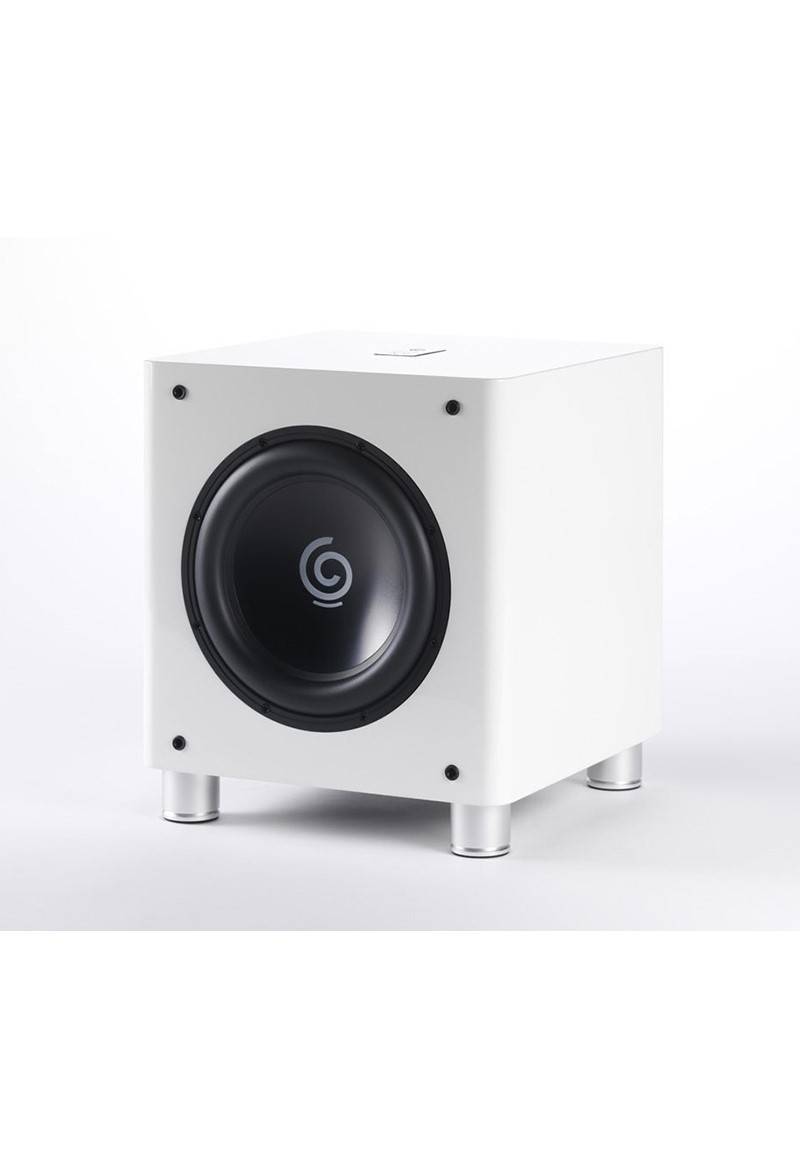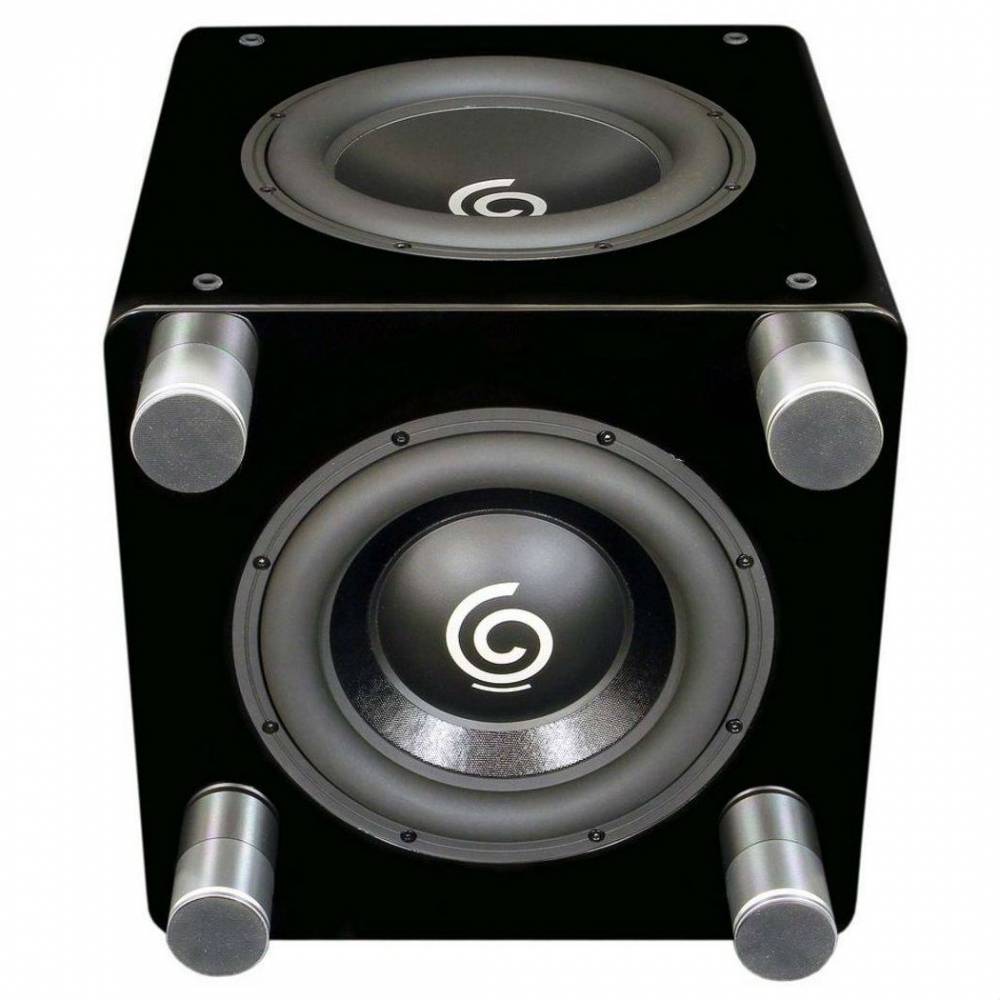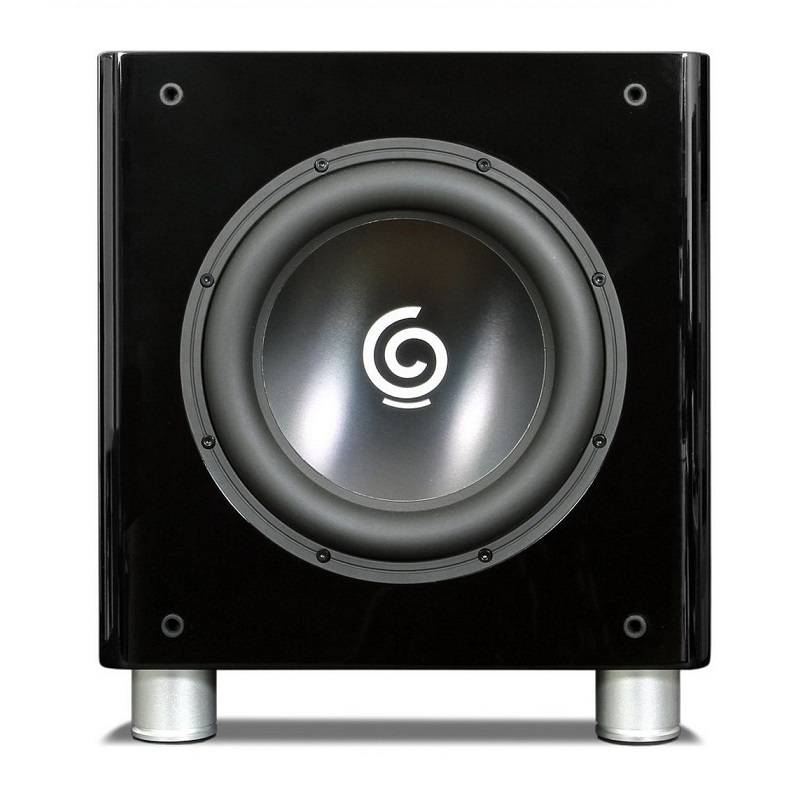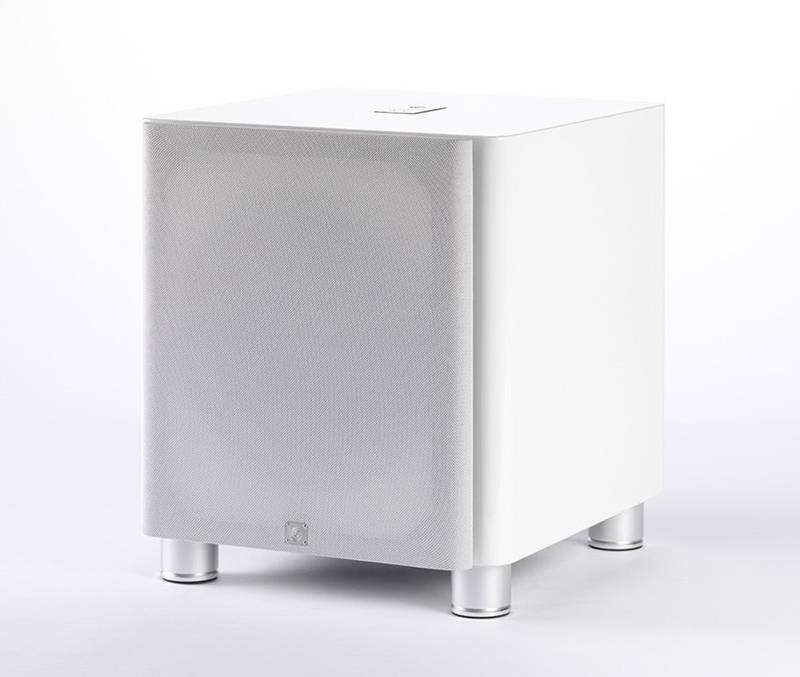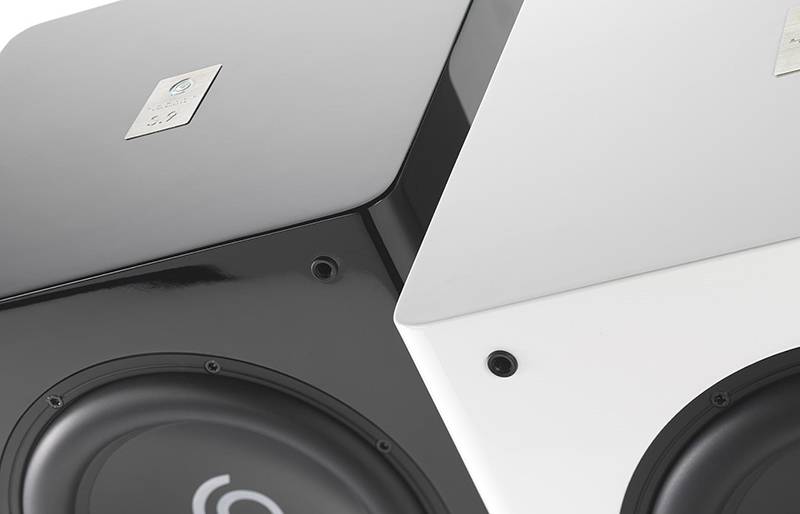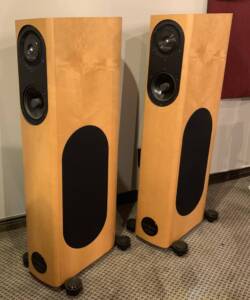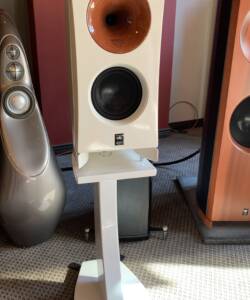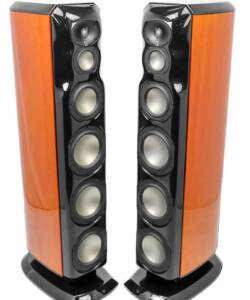Sumiko S.9 Subwoofer – White
Original price was: R28,000.00.R9,800.00Current price is: R9,800.00.
Sumiko S.9 Subwoofer
- Beautiful, compact design
- Excellent fit and finish
- Active driver + passive radiator design
- Very deep bass given the rather small dimensions
- Excellent impact, dynamics, and raw power
- Tight, extremely musical bass with great bass definition
- Integrates amazingly well with your speaker system
- Truly elevates the performance of even “full-range” speakers
- Unique high-level Neutrik connection as well as low-level and LFE inputs allows incredible setup flexibility
- Requires a bit more work to achieve optimal setup due to multiple setup options
Sumiko is a name that many of you may be familiar with. For many years, they have produced some of the most well regarded turntable styli in the world. Sumiko is also the name of the distribution company that has handled US sales of Sonus faber and other Fine Sounds brands. So why is Sumiko now offering a line of subwoofers? Technically, the full name is Sumiko Subwoofers by Sonus faber. So why didn’t they just call them Sonus fabers? While designing subwoofers that mated well with Sonus faber speakers was of course a primary engineering goal, Sonus faber set out to create truly universal subwoofers that would blend well with just about any speaker line. As such, these subwoofers eschew the design (and name) of prior Sonus faber-branded subs and take on a look all their own.
Sumiko Sub, Sumiko, Sumiko S.9, Secrets Sub Reviews 2015, Sonus faber, Sonus
They also offer more setup options than is normal, broadening their ability to integrate properly with just about any type of speaker. The line currently consists of three models, the super-small S.0 (single 6.5” woofer, $499 MSRP), the still-pretty-small S.5 (single 8” woofer, $699 MSRP) and the more moderately size S.9 reviewed here. Sumiko was kind enough to send me two examples of the S.9 as my 24’ x 28’ listening room is difficult to drive with just a single sub.
I think I can sum up the overall design of Sumiko S.9 subwoofer in just one word: elegant. While not blazing any new design trails in subwoofer design, Sonus faber’s Chief of R+D Paolo Tezzon and Chief of Industrial Design Livio Cucuzza have managed to put their typically classy spin on what would otherwise be a boring box.
The corners of the 25mm thick MDF cabinet are gently rounded, and the metal feet are nicely styled cylinders in a satin finish. The Piano Gloss Black of my two review samples was gorgeous. For an even more contemporary look the S.9 is also available in a high-gloss white lacquer. I couldn’t find any blemishes or inconsistencies in the finish on either sample which is remarkable given the price point. On the top of the S.9 is an etched metal “Sumiko” logo that glows with a soft white light when the sub is powered on. Unfortunately there is no way to dim or turn off the light.
Personally, I would like to see a switch or button that enabled a high/medium/low/off setting for the logo light. At least the top mount location of the light prevents it from being too distracting in a darkened room. Also, since the Sumiko logo covering the light is made from a very thin slice of metal, it can feel a bit sharp if you ever run your hands over it. Be careful when dusting the top of the sub as your duster can easily get caught on the logo and bend or break it. A mesh covered grill rounds things out and is easily attached with a simple four-post design.
The S.9 employs two 10” woofers, each emblazoned with the Sumiko Subwoofers logo. The first is a carbon-reinforced paper active down-firing woofer with the second aluminum-coned front-firing unit being passive. Both units are considered to be “very long throw” designs. So why go with an active/passive arrangement? Per Sumiko: “Since the active drive unit is very good, and the passive unit uses an aluminum cone, placing the passive on the front gives us equal low bass response to an opposing driver arrangement, but better impact and solidity in the upper bass. The 90 degree offset offers the ability to drive multiple room modes while maintaining some aspects of the mono-polar sub sound by having one drive surface aimed forward, the best compromise at this price it would seem. As I’m sure you’ve experienced, most subs that have two side-firing drivers 180 degrees apart can drive a room, but never seem to ‘hook up’ to the speaker. The bass is just sort of ‘out there’. Efficient, but sort of unrelated to the music.”
Moving around to the back panel is where things differ a little from the norm. The S.9 has three separate input options. There is the standard single RCA LFE input that most of us are very familiar with as well as a single Lo-Level RCA input. The real difference lies in the inclusion of a Neutrik Speakon Hi-Level connector. Compared to standard speaker level inputs the Neutrik offers the advantages of a gas-tight fitting as well as an input impedance of 100,000 ohms to ensure that the signal to the speakers is not degraded and that no additional load is put on your amplifier.
The Neutrik connection can be used simultaneously with the LFE or Lo-Level input and the back panel has two separate level dials to match the output levels if using both types of input. There is also a dial for adjusting the low-pass crossover point anywhere between 30Hz and 120Hz.
Finishing off the control panel is a two position phase switch (0 or 180 degrees) and a switch to toggle between a permanently on or auto-on (when a signal is detected) mode. If you need to completely shut down the sub there is a separate rocker switch beneath the power cord input. There is also a fairly large heatsink to dissipate heat from the 350W RMS Class AB amp. Personally I was surprised to see a Class AB amp as opposed to the increasingly common Class D designs that many other manufactures are now employing.
Like Sonus faber’s Venere range of speakers, all three of Sumiko’s subwoofers are manufactured in China. Fine Sounds went to great lengths to ensure that their Chinese factory was producing a quality product and that effort has paid off here. While some may scoff at the place of manufacture, I thought that the overall construction quality was excellent, especially given the price point. I think the following statement by Sumiko sums up the overall design and construction best: “The cabinet, amp, and driver construction work together to create our sound. Most competing subs at this price use a high-wattage Class D amp with a stiff, low compliance driver in a thin, poorly-braced cabinet. Most of the cost in these competing designs is the driver with little left over for the other components. Such designs rely on the amp as the propulsion, and the driver’s suspension as the ‘brake’. These designs are unable to respond to small, subtle signal changes resulting in the typical homogenous subwoofer sound. Such compromised cabinets also vibrate in sympathy giving the impression of increased output.
By contrast, Sumiko subs begin with a thicker more rigid cabinet (25mm MDF) producing a more solid foundation for the driver. An expensive high-current amp (Class AB) is used to produce both power and control, allowing a driver with higher compliance to respond thoroughly to all aspects of the input signal, both large gestures and tiny details: similar to the quality loudspeakers with which our subs are paired.” This sure sounds good to me, but the proof is in the pudding as they say so I think it is about time to see if the S.9 delivers the goods sonically.
Sumiko sent me two S.9s for review for a few reasons. First, these are “only” 10-inch subwoofers and my listening room measures roughly 24 x 28 feet totaling about 5000 cubic feet. This is a lot of space to fill for any subwoofer, particularly if you want to produce clean, even bass response.
Second, Sumiko’s preferred setup in a multi-channel environment is one subwoofer mated to the front main speakers, another dedicated to the center channel, and yet one more matched to the side surrounds. All subs should be connected using the Neutrik input as well as the LFE input. This will give the end user the experience of having full-range speakers for each of the five main channels with the additional bass provided by the .1/LFE channel as well. If you were installing the S.9s in a 2-channel stereo setup, one S.9 per speaker would be the ideal configuration, again connected via Neutrik.
As I’d never used a similarly equipped product myself I was very happy when Fine Sounds offered to send not one, but two of their staff to my home to assist in the setup process. I was fortunate to have Allan Haggar, Brand Manager for Sumiko Subwoofers and Mike Russo, Regional Sales Manager for Fine Sounds Group on hand to show me how to best integrate the S.9s into my setup (plus they were also assisting in the setup of a full multi-channel Sonus faber Olympica system – review to follow).
Using the subwoofer portion of Sumiko’s MASTERS speaker setup process, Allan and Mike placed the first subwoofer in the front left corner of my room, slightly behind and to the left of my left front main speaker with the passive driver aimed towards my primary listening seat. S.9 #1 would be mated with my front left and right speakers. The second subwoofer was placed close to the back wall of my room, almost directly behind my primary seating position with the passive driver also pointed towards to my main listening spot. S.9 #2 would be paired with the left and right surround channels.
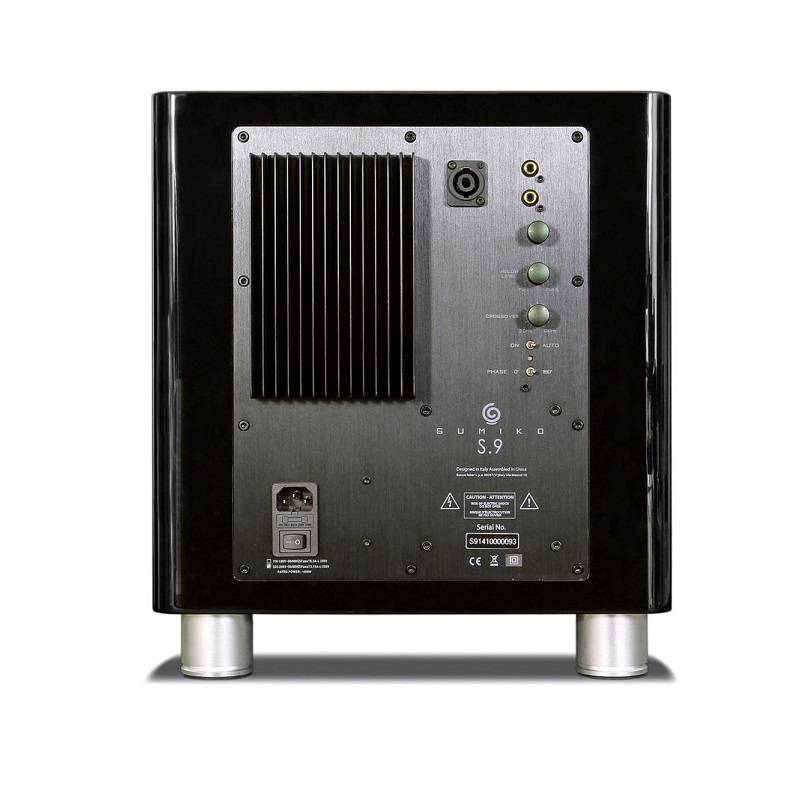
The initial connections were made via the included 30-foot Neutrik wires. Pay close attention to the setup instructions when using the Neutrik connection. The wiring is different if your amplifier is fully-balanced versus unbalanced. Balanced amplifiers also require grounding one of the 3 Neutrik wires to the chassis, so be sure that you find a good clean grounding point or you will get some audible hum through your system.
Also, don’t forget to set any speakers that will be run with the S.9 to “large” in the setup menu of your receiver/pre-amp. With the help of some carefully selected CD tracks, Allan and Mike carefully dialed in the crossover point and Hi-Level volume control of each S.9/speaker pair until they received a seamless integration between subwoofer and speaker. While I typically use some form of SPL meter and software (like the XTZ Room Analyzer II Pro kit I keep on hand) for a job like this, I couldn’t believe how perfect Allan and Mike nailed the setup by ear. I was greatly impressed with the overall effectiveness of the Sumiko MASTERS methodology. As the majority of Sumiko/Sonus faber dealers are trained in this program, I would highly recommend that a potential buyer request this setup as part of their purchase.
With the Neutrik connections setup, Allan and Mike then moved on to adding the LFE connection to the mix. Unfortunately, they ran into some grounding issues with my amplifier that prevented them from using both the Neutrik and LFE connections simultaneous.
After Allan and Mike left, I was able to figure out that the grounding issue was simply that we weren’t getting a good ground to the chassis of my Wyred 4 Sound amp. The chassis screws on the amp are anodized, so I had to loosen a screw to the point where the raw, non-anodized metal was visible and ground the Neutrik cable to that. Using some movie soundtracks with strong LFE output, I then dialed in the LFE volume level on each sub to match up with the output of the Neutrik-derived bass. Now I would have the best of both worlds: full range response from each of my mains and surrounds, plus 2 LFE-channel reproducing subs.
With all of the setup finally out of the way it was time to give the S.9s a whirl. As I mentioned earlier, the S.9s were initially setup as part of a complete 5.2 system featuring a full setup of Sonus faber Olympicas (Olympica IIIs for the fronts, Olympica Center, and Olympica Is for the surrounds). While the two S.9s sounded absolutely stunning with the Olympicas, I thought I’d push the S.9s a little harder by pairing them with my existing speaker system. This was also a good test of Sumiko’s desire to have these subs used with non-Sonus faber speakers.
Starting with straight 2-channel music fed via analog output from my Oppo BDP-83SE to my Marantz AV8801 pre/pro in “Pure Direct” mode (bypassing all of the Marantz’s processing while strictly using the Neutrik input on the S.9), I was able to see how a single S.9 augmented my front main speakers. My current reference speakers feature a single side-firing 10” woofer that enables the speakers to cleanly reach about 35Hz in my room. The addition of the S.9 to the pair added far more to the overall sound than I expected. I knew that I’d be adding at least another 10Hz of bass response, but I was not prepared for the increase in bass clarity and sound staging that the S.9 added to my stereo listening.
RachmaninoffThe tympani on Track 1 from Rachmaninoff’s Symphonic Dances (CD: Reference Recordings RR-96CD) took on a completely different gravitas with the S.9 in the mix. Besides the obvious increase in bass depth, my main speakers seemed to have grown larger; there was absolutely no discontinuity between the S.9 and my towers. There was a sense of effortlessness to my speakers that I hadn’t heard before. There was also a noticeable increase in the size of the soundstage. While this track has always sounded good in my system, crescendos now resulted in a wall of sound coming from the front soundstage.
Bass detail and clarity was a noticeable step up from what I hear from my Hsu VTF-3 MkII as well, with it being far easier to distinguish individual hits of the drum skins. There was also a more natural decay to bass notes, with the S.9 being able to reproduce not just the initial hit, but the smaller reverberations that follow. Bass was also smoother across the frequency band, with less peaks and troughs that I typically hear at my listening position.
Overall, I was amazed at how much more lifelike the overall bass was. Sumiko/Sonus faber are clearly on to something with the 90 degree active/passive woofer arrangement as well as the driver and amp choices. While my current Hsu is a very musical subwoofer, it is still a ported design, which almost always takes a back seat to a sealed design in terms of pure musicality and articulation. My Hsu (connected via LFE and crossed-over to my mains at 40Hz by my pre-pro) never sounded as well integrated as the S.9 did.
Wanting to hear more of the S.9’s strengths, I moved on to some Melody Gardot. “Your Heart Is As Black As Ice” from My One and Only Thrill (CD: Verve B001NESPHC) features a great bass line and the S.9 helped deliver it with exquisite detail. I had just received Ms. Gardot’s latest album, Currency of Man, (CD: Verve B00UNYJQ76) and found myself listening to the whole album in one shot. Again, the pairing of the S.9 to my towers was completely seamless, never once hinting that this was a separate subwoofer/satellite type setup.
While recorded a touch bass heavy, this showed off the pure musicality of the S.9. “Bad News” and “She Don’t Know” in particular showed just how fast and accurate the bass through the S.9 was. The word that kept springing to my mind was “nuanced.” It was so easy to distinguish between differing bass notes. I’ve never heard such detail in the bass before in my room. More revealing was shutting down the S.9 in the middle of one of these songs. The soundstage collapsed and my main speakers seemed to shrink down in size a notch. I can assure you, the effect was not subtle. The effortless swagger of these bass-line driven songs simply deflated when the S.9 was taken out of the mix.
ReanimationAlready extremely happy with what a single S.9 could do for stereo sources, I brought out some of my heavier hitting high-resolution material. I was expecting the bass-heavy Linkin Park DVD-Audio disc Reanimation (DVD-Audio: Warner Brothers B00006L7MV) to be an absolute revelation with both S.9s in the mix. However, when I fired up track 5, “FRGT/10” all I heard was muddy bass at a fairly low output level. So I went into my Marantz pre-pro’s setup menu and turned off the two subwoofer/LFE outputs. Restarting the track, I was punched in the face with bass output.
Re-enabling the subs killed the bass so I went searching through the setup menus for potential problems. It turns out the LFE channel delays/distance compensation settings were still configured from my Hsu. Changing the distances to match what was set for my main and surround speakers did the trick. Now both main channel bass notes and LFE derived ones were arriving at each S.9 in harmony. Restarting the track once again blew my mind. “Reanimation” is one of the few surround discs I’ve heard that has truly full range sound in each channel of the mix (plus a killer .1/LFE channel) and wow did it sound great.
I felt like the guy in the old Maxell commercials as the wall of sound just slammed into me. However, it wasn’t just loud (and believe me, I cranked it up). The bass was incredibly tight and delineated. With a second sub in the mix bass depth increased nicely as well. While I always knew that having multiple subwoofers is almost always better than having just one, I had never experienced it in my listening room until now. Having two subs greatly smoothed out the bass response at my listening position and dramatically filled in a few of the sucks outs in my overall room response. I restarted the disc from the beginning and listened to every single track, completely enjoying myself. The difference that having full range sound from the front channels as well as the surrounds makes cannot be understated. Plus I had two LFE channels on top of that! I was only sorry that I couldn’t follow Sumiko’s recommendation and have a third S.9 hooked up to the center channel as well.
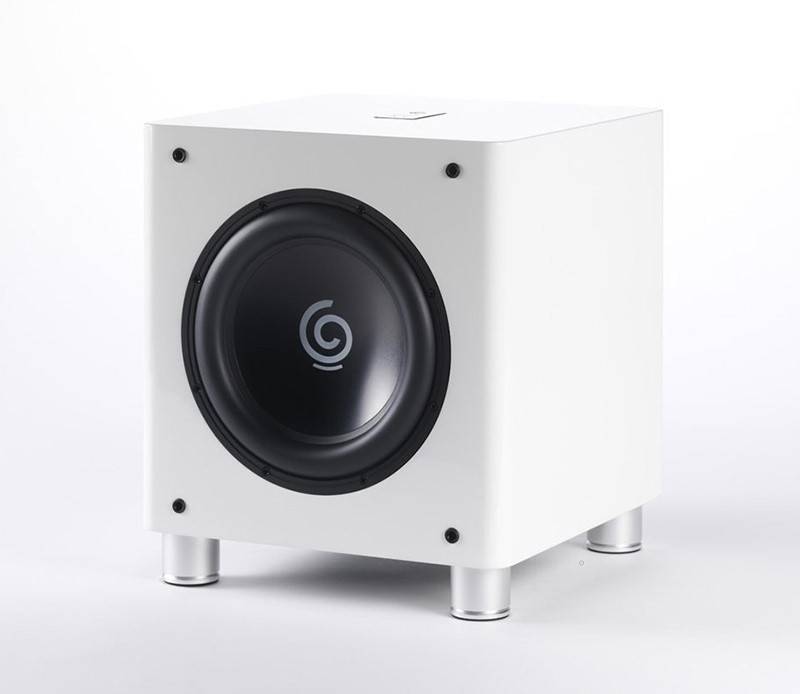
Talking HeadsThe remixed version of “Burning Down the House” from the DVD-Audio disc of the Talking Head’s Speaking in Tongues (Dual Disc: Rhino B000CCD0FI) was similarly amazing. This is another DVD-Audio mix that uses full-range sound in every channel so the benefits of the S.9s were immediately apparent. Once again, the level of bass integration with the main and surround speakers was outstanding. I wound up listening to this whole disc as well, reveling in the overall improvements offered by having two subs evening out my bass response and adding so much additional weight and power to the experience from all corners of the surround field. This is a more subtle (though still powerful) mix and I once again marveled at how much detail and nuance there
MetallicaI realize that I have spent a lot of words discussing the S.9s with music, but movie playback was similarly excellent. The DTS-HD soundtrack on Metallica’s Blu-ray concert disc Quebec Magnetic continued to show off the S.9s’ strengths. While the two subs could deliver plenty of output and slam, they were still able to show off their innate musicality. I’ve watched this disc countless times on a myriad of systems but this was the first time that I could so easily discern Robert Trujillo’s bass lines. Each bass note was clearly distinguishable from the next, even when playback approached the 100dB mark. Again, this combination of power and detail was intoxicating and I found myself listening to the majority of the concert before shutting things down for the night.
Interstellar and American SniperInterstellar and American Sniper also sounded fantastic with the S.9s in my system. The two S.9s were able to recreate the deep bass effects of Interstellar (particularly the crash scene and shuttle launches) with just as much impact as my Hsu, but with increased levels of detail and improved frequency response. Even more impressive was what the two subs did for Hans Zimmer’s musical score. The S.9s really filled out the bottom end of the soundtrack. When the music score swelled, the soundstage just opened up and enveloped me. While “American Sniper” had a less involving soundtrack, the battle scenes gave the S.9s a thorough workout. Gunshots and explosions in particular seemed to sound even more realistic than usual due to the speed and accuracy of the S.9s.
The initial “crack” of each shot seemed to ring a bit clearer and the reverberation from each explosion decayed far more accurately into the background. However, my Hsu held a clear advantage in terms of raw output and bass depth, though I never felt that the S.9s weren’t loud enough. However, I did notice that bass response started trailing off around 30Hz whereas my Hsu is flat down to about 20Hz (with usable output down to about 15Hz). I’d say the -3dB at 25Hz spec that Sumiko publishes is spot on but you can easily improve on this by running more than one S.9.
However, the comparison between the S.9 and my Hsu is a bit of an unfair one, as the Hsu has the advantage of a 12” driver, porting, and an overall cabinet volume roughly double in size. As my wife said, “I like these S.9s much better than that giant refrigerator-looking thing you have now.” Given the S.9s perfectly seamless integration with my speakers and how much smoother and more accurately they reproduced bass notes, I didn’t mind trading off those last few hertz of output. However, the bass junkie in me couldn’t help but wonder how a Sumiko sub with a couple of 12” or 15” drivers would sound (pretty please Sumiko).
THE SUMIKO S.9 SUBWOOFER has an excellent design.
- Elegant design
- Excellent construction quality
- Very accurate, musical bass
- Good bass extension for the cabinet size
- Powerful enough for all but the largest rooms
- Amazing integration with main speakers
- Multiple setup options means installation and integration is a bit more difficult than other subwoofers
- Bass response starts to taper off around 30Hz (-3dB at 25Hz rating)
Hearing what the Sumiko S.9s could do for my system was a bit of a revelation for me. While I’ve heard quite a few subwoofers in my time, I have never heard one that integrated so well into a combination music and theater system. The S.9s did so much more than just deliver some extra low frequency bass for movies. They raised the musical capabilities of my front and surround speakers to completely new heights. While the extra bass was welcome, what really thrilled me was the amount of additional bass detail that was audible and how my whole system seemed to open up when I installed the S.9s.
Frankly, I never thought I had installed separate subwoofers. Each individual speaker now sounded like it was producing full range sound. If all subs integrated into a system this well “subwoofer” would not be a four-letter word within the audiophile community. The Sumiko S.9 subwoofers have dramatically raised my expectations for a subwoofer of any price now that I know how much additional bass detail and information a well-designed sub can add to my listening sessions.
The S.9 is a product that can offer both the music and movie enthusiast something unique in the subwoofer market; raw power combined with incredible musicality. Factor in the modest dimensions, elegant styling, first-rate construction, and reasonable price point and it looks like Sumiko has a real winner on their hands with the S.9. Considering that the S.9 and its two siblings are just the opening round of products in the Sumiko Subwoofers line I can’t wait to see (and hear) what comes next.
Description
DESIGN:
Sealed Box Subwoofer
DRIVERS:
1 x 10” Steel-Chassis, Long-Throw Active Woofer (Down-Firing), 1 x 10” Passive Radiator (Front-Firing)
INPUT CONNECTORS:
1 x Neutrik Speakon High-Level, 1 x RCA LFE, 1 x RCA Low-Level
CROSSOVER:
30-120Hz Adjustable Low-Pass
MFR:
25 Hz (-3 dB) – 120 Hz
AMPLIFIER TYPE:
Class AB
AMPLIFIER POWER:
350W RMS, 700W peak
DIMENSIONS:
15.9 H x 14 W x 16.2″ D Including Feet
WEIGHT:
46.2 Pounds
FINISHES:
Gloss Piano Black or White Lacquer
MSRP:
$999 USD
